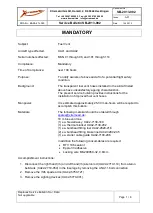
______________________________________________________________________________
30
but only recently have we discovered that
paragliders may also be affected. It is
more likely to happen with new wings
where the cloth is still highly hydrophobic
and the drops thus do not penetrate but
remain on the surface.
We know from computer simulations and
practical tests that this is physically
possible but we also suspect that it occurs
very seldom in real life flying.
In both cases the brake line travel
becomes very short and even small input
may
suddenly
induce
an
airflow
separation; in some cases even a gust or
a sudden thermal may change the angle
of incidence enough to cause the deep
stall.
If you find yourself flying in unavoidable
rain we strongly recommend that you
avoid any sudden movements or radical
brakeline input, that you do not pull Big
Ears or B-stall, and that you steer clear of
turbulence and avoid a deep flare on
landing.
WARNING!
Avoid flying in very
humid air or in rain. A wet
canopy
may
have
very
unpredictable
flying
characteristics, one of which is a
radically increased risk of deep stall!
Adhesive logos
Always make sure that your intended logo
will not in any way influence the glider
behaviour. If in doubt we suggest avoiding
the attachment of advertising logos on the
wing. UP cannot be held responsible for
any mishaps caused by intentional after-
sales changes done to the wing.
NOTE!
The
use
of
heavy
and/or
unsuitable sticky material for logo work on
the
canopy
may
compromise
the
certification and lead to the aircraft
becoming unsafe to fly
.
Overloading
The UP Trango XC³ is a very strong
paraglider, and flying all the usual SIV
and acro manoeuvres will not normally
pose a structural problem. However,
frequent acro training does accelerate
the ageing process dramatically, and
UP recommends having wings that are
often used for acro or SIV-type
manoeuvres subjected to checkups at
shorter
intervals
than
normally
stipulated.
Salt water
If you do most of your flying near the
sea, where the air is humid and salty,
the wing may age faster. In this case
we suggest you have it checked more
often than prescribed in this manual.
Maintenance and
cleaning
Taking care of your
paraglider
The wear and tear that your paraglider
suffers depends on a number of
factors; h
ow frequently it’s flown,
whereabouts in the world you fly it,
how much UV it gets and how well you
look after it. Bear in mind the following
maintenance points:
Packing your wing
The Trango XC
3
design uses ASS
Nylon battens as reinforcements in the
leading edge. This means that you can
pack it “any” way you prefer, the












































